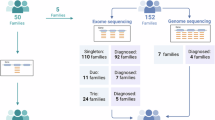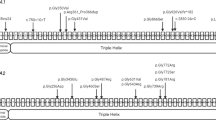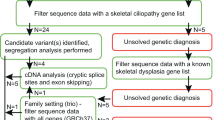Abstract
Molecular diagnosis of genetic bone dysplasia is challenging for non-expert. A targeted next-generation sequencing technology was applied to identify the underlying molecular mechanism of bone dysplasia and evaluate the contribution of these genes to patients with bone dysplasia encountered in pediatric endocrinology. A group of unrelated patients (n=82), characterized by short stature, dysmorphology and X-ray abnormalities, of which mucopolysacharidoses, GM1 gangliosidosis, mucolipidosis type II/III and achondroplasia owing to FGFR3 G380R mutation had been excluded, were recruited in this study. Probes were designed to 61 genes selected according to the nosology and classification of genetic skeletal disorders of 2010 by Illumina’s online DesignStudio software. DNA was hybridized with probes and then a library was established following the standard Illumina protocols. Amplicon library was sequenced on a MiSeq sequencing system and the data were analyzed by MiSeq Reporter. Mutations of 13 different genes were found in 44 of the 82 patients (54%). Mutations of COL2A1 gene and PHEX gene were found in nine patients, respectively (9/44=20%), followed by COMP gene in 8 (18%), TRPV4 gene in 4 (9%), FBN1 gene in 4 (9%), COL1A1 gene in 3 (6%) and COL11A1, TRAPPC2, MATN3, ARSE, TRPS1, SMARCAL1, ENPP1 gene mutations in one patient each (2% each). In conclusion, mutations of COL2A1, PHEX and COMP gene are common for short stature due to bone dysplasia in outpatient clinics in pediatric endocrinology. Targeted next-generation sequencing is an efficient way to identify the underlying molecular mechanism of genetic bone dysplasia.
Similar content being viewed by others
Log in or create a free account to read this content
Gain free access to this article, as well as selected content from this journal and more on nature.com
or
References
Warman, M. L., Cormier-Daire, V., Hall, C., Krakow, D., Lachman, R., LeMerrer, M. et al. Nosology and classification of genetic skeletal disorders: 2010 revision. Am. J. Med. Genet. A 155A, 943–968 (2011).
Volodarsky, M., Markus, B., Cohen, I., Staretz-Chacham, O., Flusser, H., Landau, D. et al. A deletion mutation in TMEM38B associated with autosomal recessive osteogenesis imperfecta. Hum. Mutat. 34, 582–586 (2013).
Miyake, N., Elcioglu, N. H., Iida, A., Isguven, P., Dai, J., Murakami, N. et al. PAPSS2 mutations cause autosomal recessive brachyolmia. J. Med. Genet. 49, 533–538 (2012).
Nampoothiri, S., Yesodharan, D., Sainulabdin, G., Narayanan, D., Padmanabhan, L., Girisha, K. M. et al. Eight years experience from a skeletal dysplasia referral center in a tertiary hospital in Southern India: a model for the diagnosis and treatment of rare diseases in a developing country. Am. J. Med. Genet. A 164A, 2317–2323 (2014).
Kannu, P., Bateman, J. & Savarirayan, R. Clinical phenotypes associated with type II collagen mutations. J. Paediatr. Child Health 48, E38–E43 (2012).
Jackson, G. C., Mittaz-Crettol, L., Taylor, J. A., Mortier, G. R., Spranger, J., Zabel, B. et al. Pseudoachondroplasia and multiple epiphyseal dysplasia: a 7-year comprehensive analysis of the known disease genes identify novel and recurrent mutations and provides an accurate assessment of their relative contribution. Hum. Mutat. 33, 144–157 (2012).
Rubinato, E., Morgan, A., D'Eustacchio, A., Pecile, V., Gortani, G., Gasparini, P. et al. A novel deletion mutation involving TMEM38B in a patient with autosomal recessive osteogenesis imperfecta. Gene 545, 290–292 (2014).
Hasegawa, K. & Tanaka, H. Children with short-limbed short stature in pediatric endocrinological services in Japan. Pediatr. Int. 56, 809–812 (2014).
Ozono, K., Namba, N., Kubota, T., Kitaoka, T., Miura, K., Ohata, Y. et al. Pediatric aspects of skeletal dysplasia. Pediatr. Endocrinol. Rev. 10 (Suppl 1), 35–43 (2012).
Yamashita, A., Morioka, M., Kishi, H., Kimura, T., Yahara, Y., Okada, M. et al. Statin treatment rescues FGFR3 skeletal dysplasia phenotypes. Nature 513, 507–511 (2014).
Cui, Y., Zhao, H., Liu, Z., Liu, C., Luan, J., Zhou, X. et al. A systematic review of genetic skeletal disorders reported in Chinese biomedical journals between 1978 and 2012. Orphanet J. Rare Dis. 7, 55 (2012).
Le Goff, C., Mahaut, C., Wang, L. W., Allali, S., Abhyankar, A., Jensen, S. et al. Mutations in the TGFbeta binding-protein-like domain 5 of FBN1 are responsible for acromicric and geleophysic dysplasias. Am. J. Hum. Genet. 89, 7–14 (2011).
Richards, S., Aziz, N., Bale, S., Bick, D., Das, S., Gastier-Foster, J. et al. Standards and guidelines for the interpretation of sequence variants: a joint consensus recommendation of the American College of Medical Genetics and Genomics and the Association for Molecular Pathology. Genet. Med. 17, 405–423 (2015).
Matos-Miranda, C., Nimmo, G., Williams, B., Tysoe, C., Owens, M., Bale, S. et al. A prospective study of brachytelephalangic chondrodysplasia punctata: identification of arylsulfatase E mutations, functional analysis of novel missense alleles, and determination of potential phenocopies. Genet. Med. 15, 650–657 (2013).
Wang, Y., Zhang, H., Ye, J., Han, L. & Gu, X. Three novel mutations of the FBN1 gene in Chinese children with acromelic dysplasia. J. Hum. Genet. 59, 563–567 (2014).
Terhal, P. A., Nievelstein, R. J., Verver, E. J., Topsakal, V., van Dommelen, P., Hoornaert, K. et al. A study of the clinical and radiological features in a cohort of 93 patients with a COL2A1 mutation causing spondyloepiphyseal dysplasia congenita or a related phenotype. Am. J Med. Genet. A 167A, 461–475 (2015).
Terhal, P. A., van Dommelen, P., Le Merrer, M., Zankl, A., Simon, M. E., Smithson, S. F. et al. Mutation-based growth charts for SEDC and other COL2A1 related dysplasias. Am. J. Med. Genet. C Semin. Med. Genet. 160C, 205–216 (2012).
Beck-Nielsen, S. S., Brixen, K., Gram, J. & Brusgaard, K. Mutational analysis of PHEX, FGF23, DMP1, SLC34A3 and CLCN5 in patients with hypophosphatemic rickets. J. Hum. Genet. 57, 453–458 (2012).
Kennedy, J., Jackson, G., Ramsden, S., Taylor, J., Newman, W., Wright, M. J. et al. COMP mutation screening as an aid for the clinical diagnosis and counselling of patients with a suspected diagnosis of pseudoachondroplasia or multiple epiphyseal dysplasia. Eur. J. Hum. Genet. 13, 547–555 (2005).
Deere, M., Sanford, T., Ferguson, H. L., Daniels, K. & Hecht, J. T. Identification of twelve mutations in cartilage oligomeric matrix protein (COMP) in patients with pseudoachondroplasia. Am. J. Med. Genet. 80, 510–513 (1998).
Chapman, K. L., Mortier, G. R., Chapman, K., Loughlin, J., Grant, M. E. & Briggs, M. D. Mutations in the region encoding the von Willebrand factor A domain of matrilin-3 are associated with multiple epiphyseal dysplasia. Nat. Genet. 28, 393–396 (2001).
Krakow, D., Vriens, J., Camacho, N., Luong, P., Deixler, H., Funari, T. L. et al. Mutations in the gene encoding the calcium-permeable ion channel TRPV4 produce spondylometaphyseal dysplasia, Kozlowski type and metatropic dysplasia. Am. J. Hum. Genet. 84, 307–315 (2009).
Majava, M., Hoornaert, K. P., Bartholdi, D., Bouma, M. C., Bouman, K., Carrera, M. et al. A report on 10 new patients with heterozygous mutations in the COL11A1 gene and a review of genotype-phenotype correlations in type XI collagenopathies. Am. J. Med. Genet. A 143A, 258–264 (2007).
Nino, M., Matos-Miranda, C., Maeda, M., Chen, L., Allanson, J., Armour, C. et al. Clinical and molecular analysis of arylsulfatase E in patients with brachytelephalangic chondrodysplasia punctata. Am. J. Med. Genet. A 146A, 997–1008 (2008).
Hoornaert, K. P., Dewinter, C., Vereecke, I., Beemer, F. A., Courtens, W., Fryer, A. et al. The phenotypic spectrum in patients with arginine to cysteine mutations in the COL2A1 gene. J. Medi. Genet. 43, 406–413 (2006).
Chan, D., Taylor, T. K. & Cole, W. G. Characterization of an arginine 789 to cysteine substitution in alpha 1 (II) collagen chains of a patient with spondyloepiphyseal dysplasia. J. Biol. Chem. 268, 15238–15245 (1993).
Nishimura, G., Haga, N., Kitoh, H., Tanaka, Y., Sonoda, T., Kitamura, M. et al. The phenotypic spectrum of COL2A1 mutations. Hum. Mutat. 26, 36–43 (2005).
Ritvaniemi, P., Sokolov, B. P., Williams, C. J., Considine, E., Yurgenev, L., Meerson, E. M. et al. A single base mutation in the type II procollagen gene (COL2A1) that converts glycine alpha 1-247 to serine in a family with late-onset spondyloepiphyseal dysplasia. Hum. Mutat. 3, 261–267 (1994).
Rowe, P. S., Oudet, C. L., Francis, F., Sinding, C., Pannetier, S., Econs, M. J. et al. Distribution of mutations in the PEX gene in families with X-linked hypophosphataemic rickets (HYP). Hum. Mol. Genet. 6, 539–549 (1997).
Morey, M., Castro-Feijoo, L., Barreiro, J., Cabanas, P., Pombo, M., Gil, M. et al. Genetic diagnosis of X-linked dominant Hypophosphatemic Rickets in a cohort study: tubular reabsorption of phosphate and 1,25(OH)2D serum levels are associated with PHEX mutation type. BMC Med. Genet. 12, 116 (2011).
Hecht, J. T., Nelson, L. D., Crowder, E., Wang, Y., Elder, F. F., Harrison, W. R. et al. Mutations in exon 17B of cartilage oligomeric matrix protein (COMP) cause pseudoachondroplasia. Nat. Genet. 10, 325–329 (1995).
Camacho, N., Krakow, D., Johnykutty, S., Katzman, P. J., Pepkowitz, S., Vriens, J. et al. Dominant TRPV4 mutations in nonlethal and lethal metatropic dysplasia. Am. J. Med Genet. A 152A, 1169–1177 (2010).
Meredith, S. P., Richards, A. J., Bearcroft, P., Pouson, A. V. & Snead, M. P. Significant ocular findings are a feature of heritable bone dysplasias resulting from defects in type II collagen. Br J Ophthalmol 91, 1148–1151 (2007).
Tiller, G. E., Hannig, V. L., Dozier, D., Carrel, L., Trevarthen, K. C., Wilcox, W. R. et al. A recurrent RNA-splicing mutation in the SEDL gene causes X-linked spondyloepiphyseal dysplasia tarda. Am. J. Hum. Genet. 68, 1398–1407 (2001).
Ludecke, H. J., Schaper, J., Meinecke, P., Momeni, P., Gross, S., von Holtum, D. et al. Genotypic and phenotypic spectrum in tricho-rhino-phalangeal syndrome types I and III. Am. J. Hum. Genet. 68, 81–91 (2001).
Acknowledgements
This project is supported by NSFC (81071121, 81270936), Shanghai Rising-Star Program (12QH1401800), Major Program of Shanghai Committee of Science and Technology (11dz195030), National Key Technology R&D Program (2012BAI09B04).
Author information
Authors and Affiliations
Corresponding authors
Ethics declarations
Competing interests
The authors declare no conflict of interest.
Additional information
Supplementary Information accompanies the paper on Journal of Human Genetics website
Supplementary information
Rights and permissions
About this article
Cite this article
Zhang, H., Yang, R., Wang, Y. et al. A pilot study of gene testing of genetic bone dysplasia using targeted next-generation sequencing. J Hum Genet 60, 769–776 (2015). https://doi.org/10.1038/jhg.2015.112
Received:
Revised:
Accepted:
Published:
Issue date:
DOI: https://doi.org/10.1038/jhg.2015.112
This article is cited by
-
Co-occurrence of Spondyloepiphyseal Dysplasia and X-Linked Hypophosphatemia in a Three-Generation Chinese Family
Calcified Tissue International (2023)
-
Discovery of sensorineural hearing loss and ossicle deformity in a Chinese Li nationality family with spondyloepiphyseal dysplasia congenita caused by p.G504S mutation of COL2A1
BMC Medical Genomics (2021)



